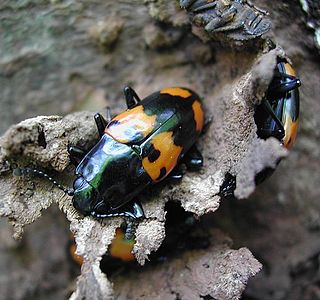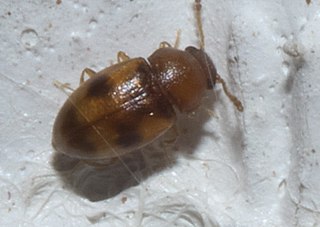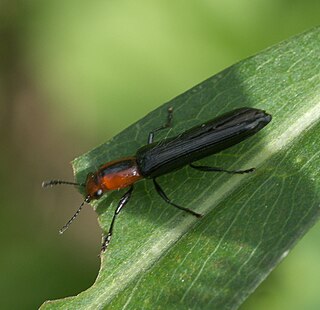
Tritoma is a genus of beetles in the family Erotylidae, the pleasing fungus beetles. It is distributed worldwide, mainly in the Old World. There are over 100 species.

Zopheridae is a family of beetles belonging to Tenebrionoidea. It has grown considerably in recent years as the members of two other families have been included within its circumscription; these former families are the Monommatidae and the Colydiidae, which are now both included in the Zopheridae as subfamilies or even as tribe of subfamily Zopherinae. Some authors accept up to six subfamilies here, while others merge all except the Colydiinae into the Zopherinae.

Cryptophagidae is a family of beetles with representatives found in all biogeographic realms. Members of this family are commonly called silken fungus beetles and both adults and larvae appear to feed exclusively on fungi although in a wide variety of habitats and situations, such as rotting wood and shed animal fur and feathers. These beetles vary from about 1 to 11 millimeters long, and usually have an oval body shape with a slight "waist".

Endomychidae, or handsome fungus beetles, is a family of beetles with representatives found in all biogeographic realms. There are around 120 genera and 1300 species. The family was established based on the type genus Endomychus, a genus erected in 1795 by Panzer which was applied to a species that Linnaeus called Chrysomela coccinea. As the common name suggests, Endomychidae feed on fungi. Crowson, in his influential treatment of the beetles, placed the family within the Cucujoidea. They have a tarsal formal of 4-4-4 or 3-3-3 and the wings lack a closed radial cell. The second antennal segment has a sensory appendage that is as long as the third antennal segment. The family has also been grouped with the Coccinellidae in a group called the Trimera for having pseudotrimerous tarsi. A 2015 molecular phylogeny study found that the Cucujoidea were found to be non-monophyletic and the Endomychidae was refined with the removal of the Anamorphinae from within the family and elevated to the status of a full family, Anamorphidae. Mycetaeinae and Eupsilobiinae were also found not to belong within the clades of the core Endomychidae, and likewise reclassified into the families Mycetaeidae and Eupsilobiidae.

Megalodacne is a genus of fungivorous beetles in the family Erotylidae.
Ischyrus dunedinensis, the three-spotted pleasing fungus beetle, is a species of pleasing fungus beetle in the family Erotylidae. It is found in North America.

Erotylinae is a subfamily of pleasing fungus beetles in the family Erotylidae.

Anamorphidae is a family of beetles in the superfamily Coccinelloidea, formerly included within the family Endomychidae. They are found worldwide. Like enchomyids, they are fungivores, with adult and larval stages thought to exclusively consume fungal spores.

Tritomini is a tribe of pleasing fungus beetles in the family Erotylidae. There are about 7 genera and at least 30 described species in Tritomini.

Toramus is a genus of pleasing fungus beetles in the family Erotylidae. There are about nine described species in Toramus.

Languriini is a tribe of beetles, known as lizard beetles, in the family Erotylidae, subfamily Languriinae. Lizard beetles are commonly found on leaves or flowers, and their larvae bore into plant stems. Adults are generally long and parallel-sided with a red thorax. There are about 5 genera and at least 20 described species in Languriini.

Xenoscelinae is a subfamily of pleasing fungus beetles in the family Erotylidae. There are about 8 genera and 12 described species in Xenoscelinae.

Pharaxonotha is a genus of pleasing fungus beetles in the family Erotylidae. There are at least three described species in Pharaxonotha.

Loberus is a genus of pleasing fungus beetles in the family Erotylidae. There are about 16 described species in Loberus.
Pseudischyrus is a genus of pleasing fungus beetles in the family Erotylidae. There are at least four described species in Pseudischyrus.
Haematochiton is a genus of pleasing fungus beetles in the family Erotylidae. There are at least three described species in Haematochiton.

Cryptophilus is a genus of pleasing fungus beetles in the family Erotylidae. There are about nine described species in Cryptophilus.
Hapalips is a genus of pleasing fungus beetles in the family Erotylidae. There are about 12 described species in Hapalips.

Cypherotylus is a genus of pleasing fungus beetles in the family Erotylidae. There are over 30 described species in Cypherotylus. It frequently appears in the literature under the name "Gibbifer", but this name is permanently unavailable under ICZN Article 11.4, as are all of Voet's names.

Dacne is a genus of pleasing fungus beetles in the family Erotylidae. There are about 19 described species in Dacne.

















